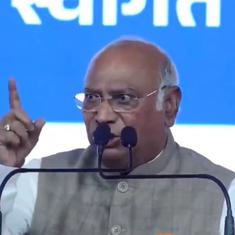The third-round Australian Open clash between 2008 champion Maria Sharapova and defending champion Caroline Wozniacki was always going to be an intensely-fought grudge match.
There is no love lost between the two, especially after a war of words at the US Open in 2017 where Sharapova, who needed a wildcard to play after returning from doping ban, was given the centre court over the then fifth seed Wozniacki.
But even without that, Sharapova was primed to cause a big upset at a Grand Slam. Wozniacki, the third seed, has not been at her physical best since being diagnosed with rheumatoid arthritis and the Russian grabbed the opportunity with both hands.
But in Wozniacki’s early exit, the world saw glimpses of the tennis that one made Sharapova great. She bombarded Wozniacki with forehand winners and kept at it even when she lost the second set to finally win 6-4, 4-6, 6-3 in two hours and 24 minutes.
Maria Sharapova knocks out defending #AusOpen champion Caroline Wozniacki 6-4, 4-6, 6-3.
— Ben Rothenberg (@BenRothenberg) January 18, 2019
That was Sharapova's best win and most complete performance in a long, long time. She faces Ash Barty next in the fourth round.
A powerful player with five Grand Slams to her name, Sharapova is always a danger in the draw, no matter what her ranking might be. If anything, her low seeding makes her a danger to the otherseeds.
The women’s field is not bereft of Grand Slam champions, but Sharapova is among the few players who are capable of putting on a scintillating, and consistent, performance. The 31-year-old has all the weapons, but has been let down by fitness and consistency since her return.
In the US Open, her first Major since her return, she overpowered second seed Simona Halep in the first round, before going down in the fourth. At the Australian Open last year, she ran into surging Aneglique Kerber in the third round, faced a similarly charged Garbine Muguruza in the French Open quarters, was stunned by Vitalia Diatchenko in the first-round of Wimbledon and went down to Carla Suárez Navarro in the fourth round in New York.
Sensational in Melbourne
She took another break from tennis for shoulder surgery in last 2018 and was critically low on match practice coming into Melbourne. The Grand Slam is only her second tournament since the US Open and shoulder surgery and at Shenzhen, she retired from her quarter-final match against Aryna Sabalenka with a thigh injury.
But her performance in the three matches in Melbourne has been dominant, dropping just three games in the first two rounds. First, she drubbed Harriet Dart 6-0, 6-0, leaving her in tears and then notched a 6-2, 6-1 win over Rebecca Peterson.
In the third-round match, Sharapova looked to be in command early on. She had three break points in the very first game but it was the Dane who drew first blood, getting a break and going 4-1 up.
But not once did Sharapova let her intensity drop. Playing a high-risk, high-reward game with 37 winners to 46 unforced errors, Sharapova clearly was not planning to hold back. Wozniacki’s corresponding ratio was 21 errors to only 10 winners.
There are some nutty stats in this 1st week but Maria Sharapova winning 17 of 23 rallies that lasted 9+ balls vs. Caroline Wozniacki is…pretty up there.
— Courtney Nguyen (@FortyDeuceTwits) January 18, 2019
The 30th seed won five games in a row to take the first set with the help of 16 winners, her composed body language backed up with clinical returning and top-notch serving. The 31-year-old Russian unleashed 23 forehand winners, a number that alarm all future opponents.
Wozniacki, a counter-puncher, admitted to losing her rhythm, especially in the long rallies. It didn’t help that Sharapova played smart tennis too.
The second set saw the third seed fight in her own way but Sharapova kept finding her angles at the right moment. Serving to stay in the match, she won a 19-shot rally to save match point but the Russian proved to be too strong in the end. Her return numbers indicate how she piled on the pressure: winning 102 return points – 41 of them on first serve – to Wozniacki’s 76.
The Russian admitted that her return game was improving.
“Thought I started returning better middle of last year but still not where I want it to be. Despite not having a lot of matches coming into the tournament, you know, this season, that’s certainly worked for me,” she said after the match.
Up next for Sharapova is 15th seed and local girl Ashleigh Barty, who has put together a steady run – winning the WTA Elite Trophy last season and reaching the finals of Sydney International in 2019.
If the Russian can muster similar firepower in her next round, there is a good chance she can blow the Australian away and match her best Grand Slam run since her return. Many would then perhaps even back her to go one better.










